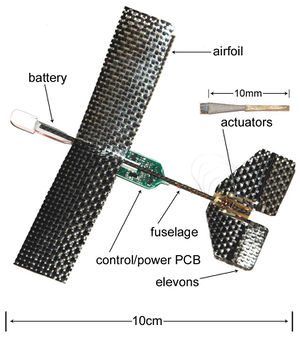Difference between revisions of "Media"
Jump to navigation
Jump to search
| Line 3: | Line 3: | ||
| style="width:50%"| | | style="width:50%"| | ||
== Paparazzi in the News == | == Paparazzi in the News == | ||
* [http://www.spiegel.de/wissenschaft/mensch/0,1518,525696,00.html SPIEGEL Online: Projekt "Paparazzi": Bau dir deinen fliegenden Spion]- December 28, 2007 | |||
*:<small>Unbemannte Mini-Flugzeuge werden derzeit vor allem von Militärs genutzt. Doch eine Drohne, die selbständig vorgegebene Routen abfliegt, lässt sich auch selbst bauen. Für etwa 1000 Euro bekommt man ein Flugzeug, das sich bequem per Software dirigieren lässt. | |||
*:Der Flieger macht nicht, was er soll: Plötzlich dreht er um 180 Grad und kehrt zum Startpunkt zurück. "Alles ist unter Kontrolle", sagt Antoine Drouin und die Zuhörer auf dem Chaos Communication Congress in Berlin lachen… | |||
</small> | |||
* [http://www.golem.de/0712/56728.html golem.de: 24C3: Paparazzi - Open-Source-Autopilot für Modellflugzeuge] - December 27, 2007 | |||
*:<small>Demo von Flugplanänderungen zweier autonomer Modellflieger über Netzwerke | |||
*:Auf dem derzeit in Berlin stattfindenden 24. Chaos Communication Congress (24C3) zeigten Martin Müller und Antoine Drouin von der Ecole Nationale de l'Aviation Civile (ENAC) vor versammeltem Hacker-Publikum wie ein wenig kostenintensiver GPS-basierter Autopilot aussieht. Mit der ebenfalls dafür entwickelten Software lassen sich mit einem Netzwerk sogar mehrere Flugzeuge an verschiedenen Standorten verwalten… | |||
</small> | |||
* [http://www.hackaday.com/2007/12/27/24c3/ HACK A DAY: 24C3 Build your own UAV] - December 27, 2007 | |||
*:<small>The 24th annual Chaos Communications Congress in Berlin is already off to a great start. The first talk we attended was [Antoine Drouin] and [Martin Müller] presenting Paparazzi - The Free Autopilot. Paparazzi is an open source hardware and software project for building autonomous unmanned aerial vehicles. The main hardware board has an ARM processor and GPS. It uses inertial and infrared sensors to determine orientation and altitude. The four infrared thermopiles measure the air temperature. The ground is warmer than the sky and if you compare the temperature in the direction of each wing tip your can tell what angle the airplane is at. It's really that simple… | |||
</small> | |||
* [http://www.elektor-electronics.co.uk/Default.aspx?tabid=27&art=53265&PN=On Elector Electronics: "Flying Robots"] - Feb 2007 | * [http://www.elektor-electronics.co.uk/Default.aspx?tabid=27&art=53265&PN=On Elector Electronics: "Flying Robots"] - Feb 2007 | ||
*:<small>As processors become ever more powerful we are witnessing the rise of more ’intelligent’ systems. We now look to sophisticated robots to assist or even replace us in difficult or hazardous environments. This is particularly true of military hardware where we have seen on our TV screens the use of unmanned aircraft and vehicles in some recent conflicts. The basic idea however is not so new; we take a look into the world of ‘drones’…</small> | *:<small>As processors become ever more powerful we are witnessing the rise of more ’intelligent’ systems. We now look to sophisticated robots to assist or even replace us in difficult or hazardous environments. This is particularly true of military hardware where we have seen on our TV screens the use of unmanned aircraft and vehicles in some recent conflicts. The basic idea however is not so new; we take a look into the world of ‘drones’…</small> | ||
Revision as of 02:24, 29 December 2007
Paparazzi in the News
|
Design Reports
|
Other Sites of Interest
- "Design, Fabrication and Initial Results of a 2g Autonomous Glider"
(900K, PDF) - July 2007- Utilizing the core technologies of emerging microrobotic structures, the rapid design and prototyping of a passive micro air vehicle with the final goal of locating an audio source while avoiding hazardous obstacles is presented. The airfoil and control surfaces are optimized empirically to maximize lift and maneuverability while minimizing drag. Bimorph piezoelectric bending cantilevers actuate the control surfaces. Since such actuators require high voltages, an efficient boost circuit is presented along with appropriate high voltage electronics. To locate audio sources, a pair of acoustic sensors is designed and prototyped using a phase detection algorithm while a custom optic flow sensor is developed to avoid obstacles and give estimates of object distances and velocities. Finally, each subsystem is demonstrated and the complete glider is integrated to demonstrate initial open loop control performance.
